Microstructure and Wear Resistance of a Cr7C3 Reinforced Ni3Al Composite Coating Prepared by Laser Cladding
Abstract
1. Introduction
2. Experimental Materials and Methods
2.1. Composite Powders
2.2. Preparation of Cladding Layer
2.3. Microstructure Characterization and Wear Test
3. Results
3.1. Micro-Analysis on Alloyed Powders
3.2. Microstructure and Phase Composition of Cladding Layer
3.3. Microhardness and Wear Properties of the Cladding Layer
4. Discussion
5. Conclusions
- (1)
- The alloyed powder cladding layer is mainly composed of Ni3Al, NiAl and in situ Cr7C3, and the in situ-formed Cr7C3 particles are tiny and evenly dispersed; the mixed powder cladding layer contains Ni3Al, NiAl, in situ Cr7C3 and partially undissolved Cr3C2, and the distribution of the Cr7C3 particles is uneven.
- (2)
- The average friction coefficient of the alloyed powder cladding layer is 0.1 ± 0.01, which is slightly lower than 0.12 ± 0.01 of the mixed powder cladding layer, and far lower than 0.55 ± 0.05 of vermicular cast iron. The wear loss of the disks related to the alloyed powder cladding layer is 0.82 ± 0.05 mg, lower than 1.42 ± 0.05 mg of the mixed powder cladding layer, and even lower compared to that of the vermicular cast iron (1.78 ± 0.05 mg).
- (3)
- The difference in tribological performance between the alloy powder and mixed powder cladding layer is mainly due to their differences in their microstructure. In situ-formed tiny Cr7C3 particles are evenly dispersed on the intermetallic matrix in the alloyed powder cladding layer, which can effectively separate the friction surface and block scratches, whereas Cr7C3 particles generated in the mixed powder cladding layer are unevenly distributed, with inferior performance in terms of separating some surface areas of tribo-pairs. Moreover, the undissolved coarse Cr3C2 particles may scratch the counterpart pair more seriously and intensify the wear. Therefore, the alloyed powder cladding layer designed, produced, and tested in this study not only has improved tribological properties but also results in less damage to counterpart materials.
Author Contributions
Funding
Institutional Review Board Statement
Informed Consent Statement
Data Availability Statement
Conflicts of Interest
References
- Li, J.; Peng, Y.; Zhang, J.; Yin, S.; Ding, J.; Wu, Y.; Wu, J.; Chen, X.; Xia, X.; He, X.; et al. Cyclic oxidation behavior of Ni3Al-based superalloyed. Vacuum 2019, 169, 108938. [Google Scholar] [CrossRef]
- Mao, R.; Fan, Z.; Xiang, D. Enhanced mechanical properties of tungsten alloy by synergistic strengthening of flaky Ni3Al and Al2O3 nano-particles. J. Alloys Compd. 2021, 898, 162790. [Google Scholar] [CrossRef]
- Khoei, A.R.; Eshlaghi, G.T.; Shahoveisi, S. Atomistic simulation of creep deformation mechanisms in nickel-based single crystal superalloys. Mater. Sci. Eng. A 2021, 809, 14097. [Google Scholar] [CrossRef]
- Gong, S.; Shang, Y.; Zhang, J.; Guo, X.; Lin, J.; Zhao, X. Application and research of typical intermetallics-based high temperature structural materials in China. Acta Met. Sin 2019, 55, 1067–1076. [Google Scholar] [CrossRef]
- Wen, Y.; Sun, J.; Huang, J. First—principles study of stacking fault energies in Ni3Al intermetallic alloyeds. Trans. Nonferrous Met. Soc. China 2012, 22, 661–664. [Google Scholar] [CrossRef]
- Kruml, T.; Conforto, E.; Piccolo, B.L.; Caillard, D.; Martin, J.L. From dislocation cores to strength and work-hardening: A study of binary Ni3Al. Acta Mater. 2002, 50, 5091–5101. [Google Scholar] [CrossRef]
- Mao, Q.; Yang, Q.; Xiong, W.; LI, S.; Zhang, M.; Ruan, L. Corrosion behavior of Ni3Al-bonded TiC-based cermets in H2SO4 and NaOH solutions. Ceram. Int. 2018, 44, 13303–13312. [Google Scholar] [CrossRef]
- Li, S.; Feng, D.; Luo, H. Microstructure and abrasive wear performance of chromium carbide reinforced Ni3Al matrix composite coating. Surf. Coat. Technol. 2007, 201, 4542–4546. [Google Scholar] [CrossRef]
- Liu, W.; Zhang, F.; Lu, J.; Chen, J.; Huang, H.; Zhou, Y.; Tang, H. Preparation of Ni3Al bonded diamond core drill with Ni–Cr alloyed and its performance on glass–ceramic. Ceram. Int. 2018, 44, 23080–23087. [Google Scholar] [CrossRef]
- Colaco, R.; Vilar, R. Abrasive wear of metallic matrix reinforced materials. Wear 2003, 255, 643–650. [Google Scholar] [CrossRef]
- Cios, G.; Bala, P.; Stepien, M.; Górecki, K. Microstructure of cast Ni-Cr-Al-C alloy. Arch. Metall. Mater. 2015, 60, 145–148. [Google Scholar] [CrossRef]
- Gong, K.; Zhou, Z.; Shum, P.W.; Luo, H.; Tian, Z.; Li, C. Tribological evaluation on Ni3Al-based alloyed and its composites under unlubricated wear condition. Wear 2011, 270, 195–203. [Google Scholar] [CrossRef][Green Version]
- Fu, L.; Han, W.; Gong, K.; Bengtsson, S.; Dong, C.; Zhao, L.; Tian, Z. Microstructure and tribological properties of Cr3C2/Ni3Al composite materials prepared by hot isostatic pressing (HIP). Mater. Des. 2017, 115, 203–212. [Google Scholar] [CrossRef]
- Gong, K.; Luo, H.; Feng, D.; Li, C. Wear of Ni3Al-based materials and its chromium-carbide reinforced composites. Wear 2008, 265, 1751–1755. [Google Scholar] [CrossRef][Green Version]
- Luo, H.; Gong, K.; Li, S.; Cao, X.; Zhang, X.; Feng, D.; Li, C. Abrasive wear comparison of Cr3C2/Ni3Al composite and stellite 12 alloyed cladding. J. Iron Steel Res. Int. 2007, 14, 15–20. [Google Scholar] [CrossRef]
- Li, S.; Wu, M.; Sun, L.; Jiang, L.; Han, Y. Fretting wear resistance of ATW Cr3C2/Ni3Al composite hardfacing on IC6SX. Mater. Sci. Forum 2010, 654, 532–537. [Google Scholar] [CrossRef]
- Ma, Q.; Dong, Z.; Ren, N.; Hong, S.; Chen, J.; Hu, L.; Meng, W. Microstructure and mechanical properties of multiple in-situ-phases-reinforced nickel composite coatings deposited by wide-band laser. Coatings 2021, 11, 36. [Google Scholar] [CrossRef]
- Sun, F.; Cai, K.; Li, X.; Pang, M. Research on laser cladding Co-based alloy on the surface of vermicular graphite cast iron. Coatings 2021, 11, 1241. [Google Scholar] [CrossRef]
- Gao, J.; Wu, C.; Hao, Y.; Xu, X.; Guo, L. Numerical simulation and experimental investigation on three-dimensional modelling of single-track geometry and temperature evolution by laser cladding. Opt. Laser Technol. 2020, 129, 106287. [Google Scholar] [CrossRef]
- Weisheit, A.; Rittinghaus, S.; Dutta, A.; Majumdar, J.D. Studies on the effect of composition and pre-heating on microstructure and mechanical properties of direct laser clad titanium aluminide. Opt. Lasers Eng. 2020, 131, 106041. [Google Scholar] [CrossRef]
- Li, M.; Han, B.; Song, L.; He, Q. Enhanced surface layers by laser cladding and ion sulfurization processing towards improved wear-resistance and self-lubrication performances. Appl. Surf. Sci. 2020, 503, 144226. [Google Scholar] [CrossRef]
- Chen, C.; Zhao, X.; Fang, Q.; Zhao, L.; Han, W.; Peng, Y.; Yin, F.; Tian, Z. Wear Resistance of Laser Cladding Ni3Al/Cr3C2 Composites. Rare Met. Mater. Eng. 2020, 49, 1388–1394. (In Chinese) [Google Scholar]
- Aoki, K.; Osamu, I. Improvement in room temperature ductility of the L12 type intermetallic compound Ni3Al by boron addition. J. Jpn. Inst. Met. Mater. 1979, . 43, 1190–1196. [Google Scholar] [CrossRef]
- Yuan, J.; Yu, Y.; Shen, J. Cermet composite coating with a ductile Ni3Al binder phase and an in-situ Cr7C3 augmented phase. Intermetallics 2021, 138, 107300. [Google Scholar] [CrossRef]
- Zhu, H.; Shen, J.; Gao, F.; Yu, Y.; Li, C. Microstructure and sliding wear performance of Cr7C3-(Ni,Cr)3(Al,Cr) coating deposited from Cr7C3 in situ formed atomized powder. J. Therm. Spray Technol. 2017, 26, 254–264. [Google Scholar] [CrossRef]
- Guo, S.; Chen, Z.; Zhang, Q.; Lou, C.; Yao, J. Effects of different pressures on laser cladding special powder prepared by gas atomization. Chin. J. Lasers 2013, 40, 150–155. [Google Scholar] [CrossRef]
- Sui, Q.; Zhou, H.; Zhang, D.; Chen, Z.; Zhang, P. Imposed thermal fatigue and postthermal-cycle wear resistance of biomimetic gray cast iron by laser treatment. Metall. Mater. Trans. A 2017, 48, 3758–3769. [Google Scholar] [CrossRef]
- Liu, H.; Yu, G.; He, X.; Li, S. Influence of powder properties on powder flow field in coaxial Powder feeding laser cladding. Chin. J. Lasers 2013, 40, 102–110. (In Chinese) [Google Scholar]
- Li, Y.; Li, C.; Yu, L.; Ma, Z.; Li, H.; Liu, Y. Characterization of γ′ precipitate and γ/γ′ interface in polycrystalline Ni3Al-based superalloys. Vacuum 2020, 176, 109310. [Google Scholar] [CrossRef]
- Zhang, T.; Sun, R. Study on pores and crack sensitivity of Ni- based composite coating by laser cladding. IOP Conf.Ser. Mater. Sci. Eng. 2015, 87, 012096. [Google Scholar] [CrossRef]
- Anthonysamy, S.; Ananthasivan, K.; Kaliappan, I.; Chandramouli, V.; Rao, P.R.V.; Mathews, C.K.; Jacob, K.T. Gibbs energies of formation of chromium carbides. Metall. Mater. Trans. A 1996, 27, 1919–1924. [Google Scholar] [CrossRef]
- Tiegs, T.N.; Alexander, K.B.; Plucknett, K.P.; Menchhofer, P.A.; Becher, P.F.; Waters, S.B. Ceramic composites with a ductile Ni3Al binder phase. Mater. Sci. Eng. A 1996, 209, 243–247. [Google Scholar] [CrossRef]
- Gong, K.; An, T.; Zhou, Z.; Tian, Z.; Li, C. Study on Wear Behaviors of Ni3Al/Cr-Carbides Cladding Layer on High Strength Steel Substrate. Adv. Mater. Res. 2014, 936, 1273–1282. [Google Scholar] [CrossRef]
- Vlasyuk, R.Z.; Radomysel’skii, I.D.; Smirnov, V.P.; Sotnik, A.A. Dissolution of Cr3C2 in a Nickel matrix during sintering I. Reaction of chromium carbide with nickel during solid-phase sintering. Powder Metall. Met. Ceram. 1985, 24, 269–273. [Google Scholar] [CrossRef]
- Fu, L.; Han, W.; Zhao, L.; Gong, K.; Bengtsson, S.; Zhou, M.; Li, C.; Tian, Z. Effects of Cr3C2 content and temperature on sliding friction and wear behaviors of Cr3C2/Ni3Al composite materials. Wear 2018, 414–415, 163–173. [Google Scholar] [CrossRef]
- Zhai, W.; Shi, X.; Wang, M.; Xu, Z. Grain refinement: A mechanism for graphene nanoplatelets to reduce friction and wear of Ni3Al matrix self-lubricating composites. Wear 2014, 310, 33–40. [Google Scholar] [CrossRef]
- Yuan, Y.; Li, Z. Effects of rod carbide size, content, loading and sliding distance on the friction and wear behaviors of (Cr,Fe)7C3-reinforced α-Fe based composite coating produced via PTA welding process. Surf. Coat. Technol. 2014, 248, 9–22. [Google Scholar] [CrossRef]
- Hu, J.; Li, D.; Llewellyn, R. Computational investigation of microstructural effects on abrasive wear of composite materials. Wear 2005, 259, 6–17. [Google Scholar] [CrossRef]
- Wesmann, J.A.R.; Espallargas, N. Effect of atmosphere, temperature and carbide size on the sliding friction of self-mated HVOF WC–CoCr contacts. Tribol. Int. 2016, 101, 301–313. [Google Scholar] [CrossRef]
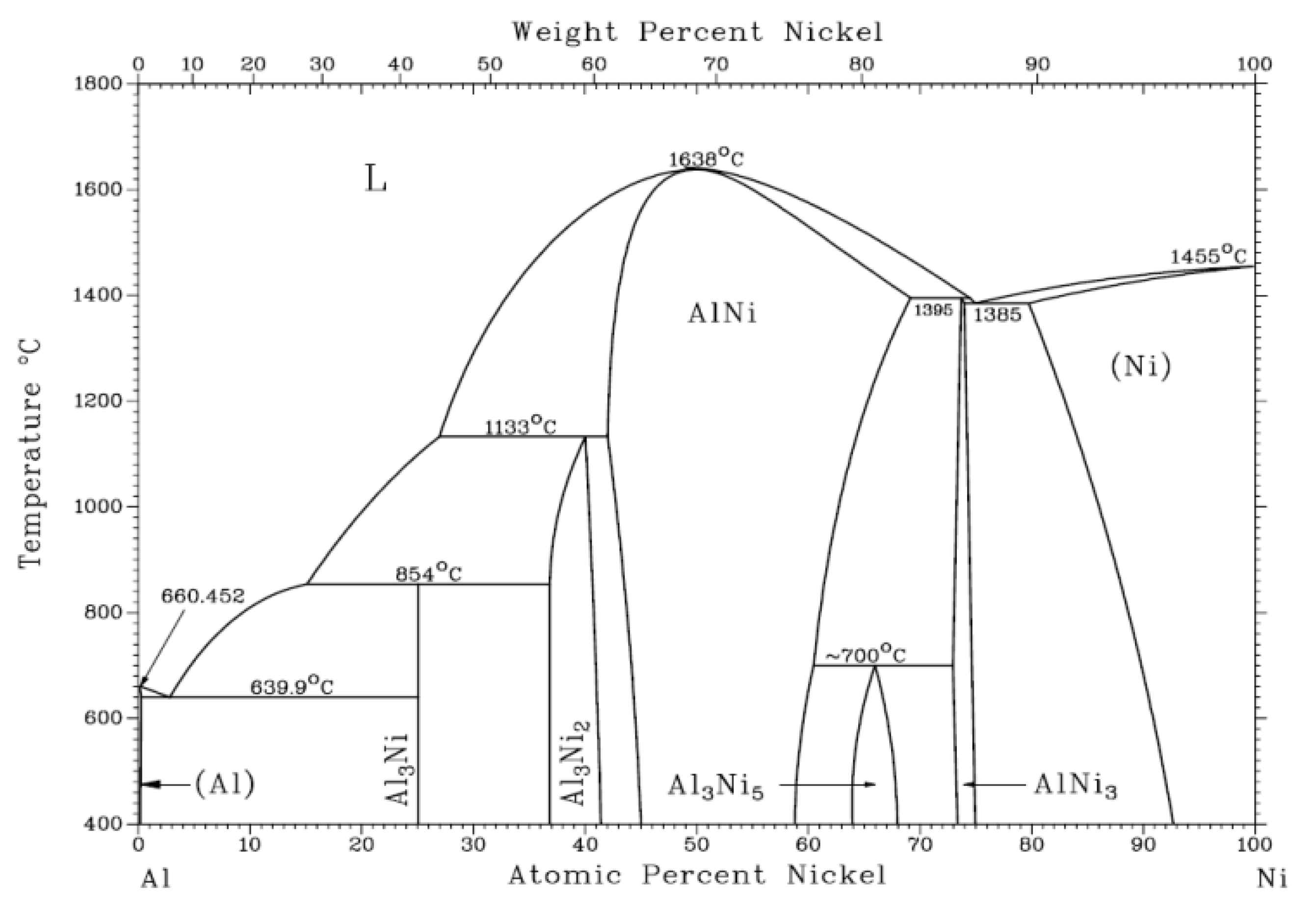
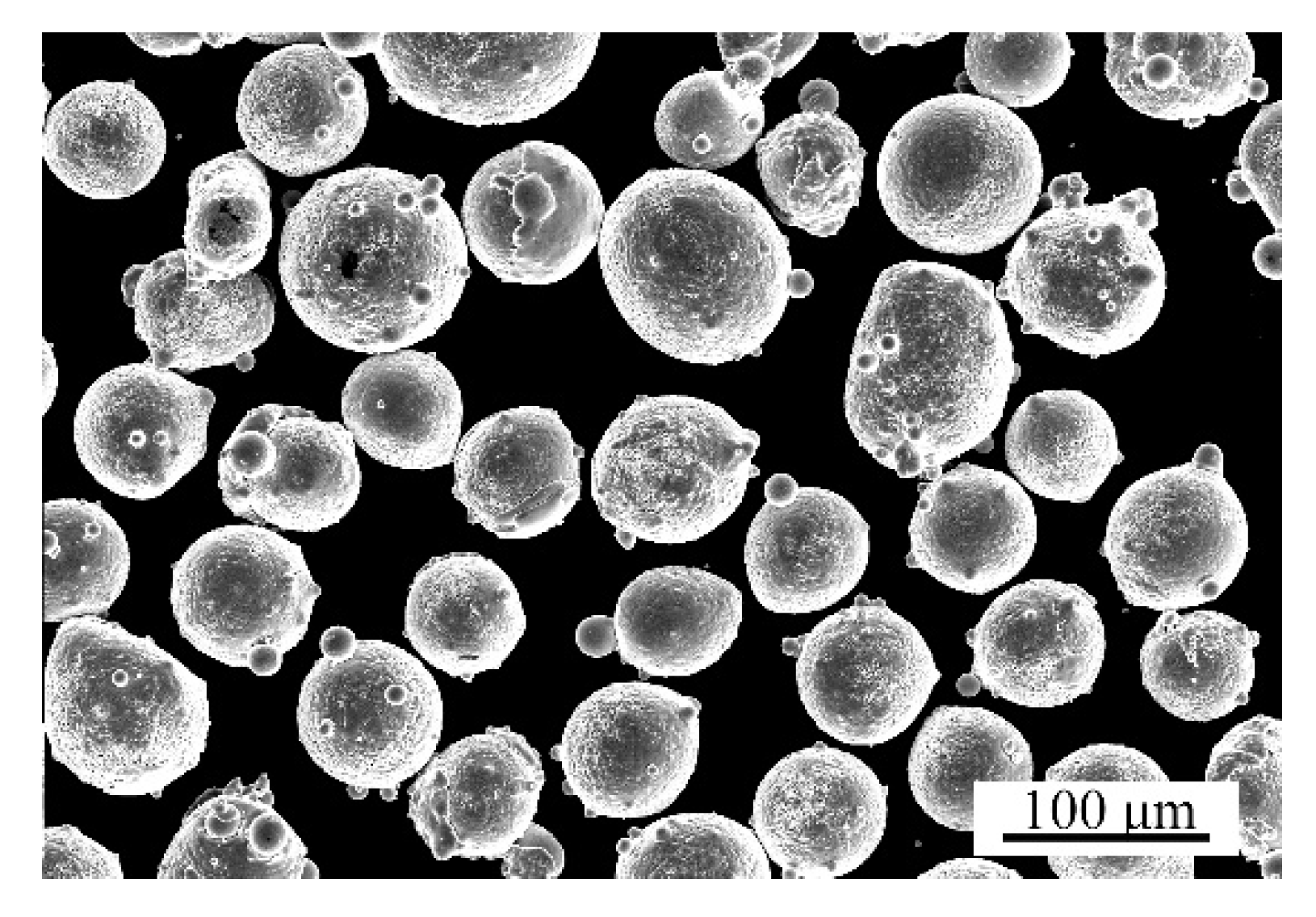

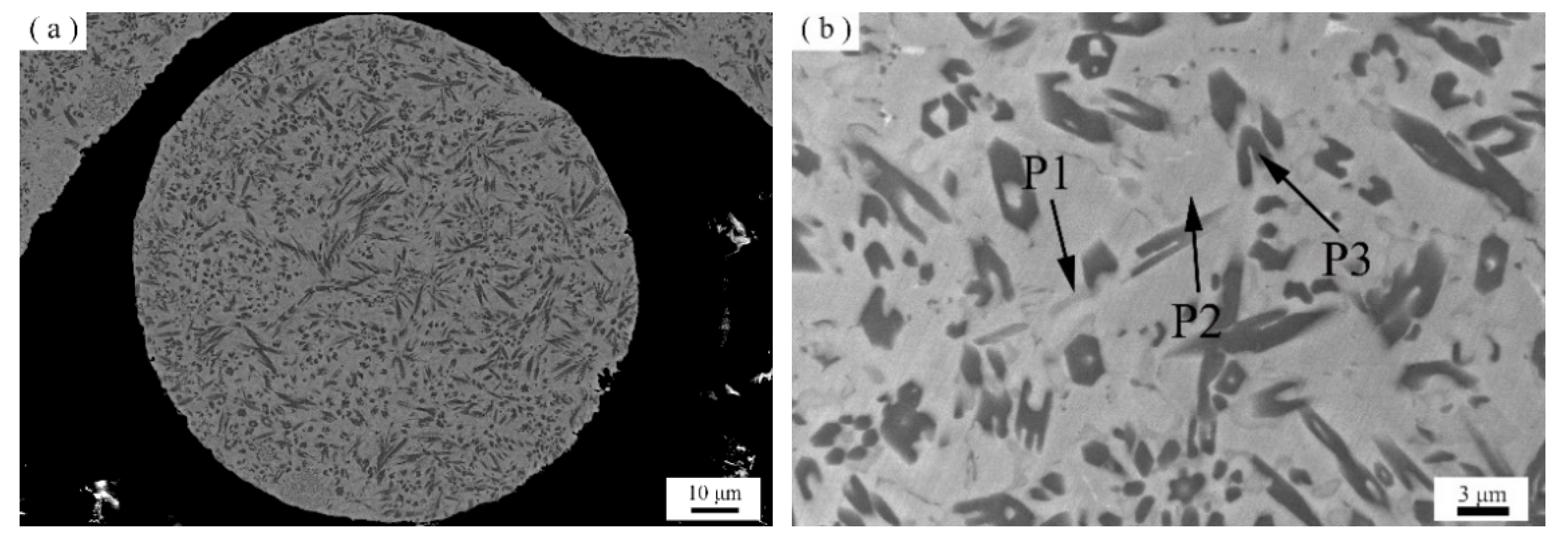
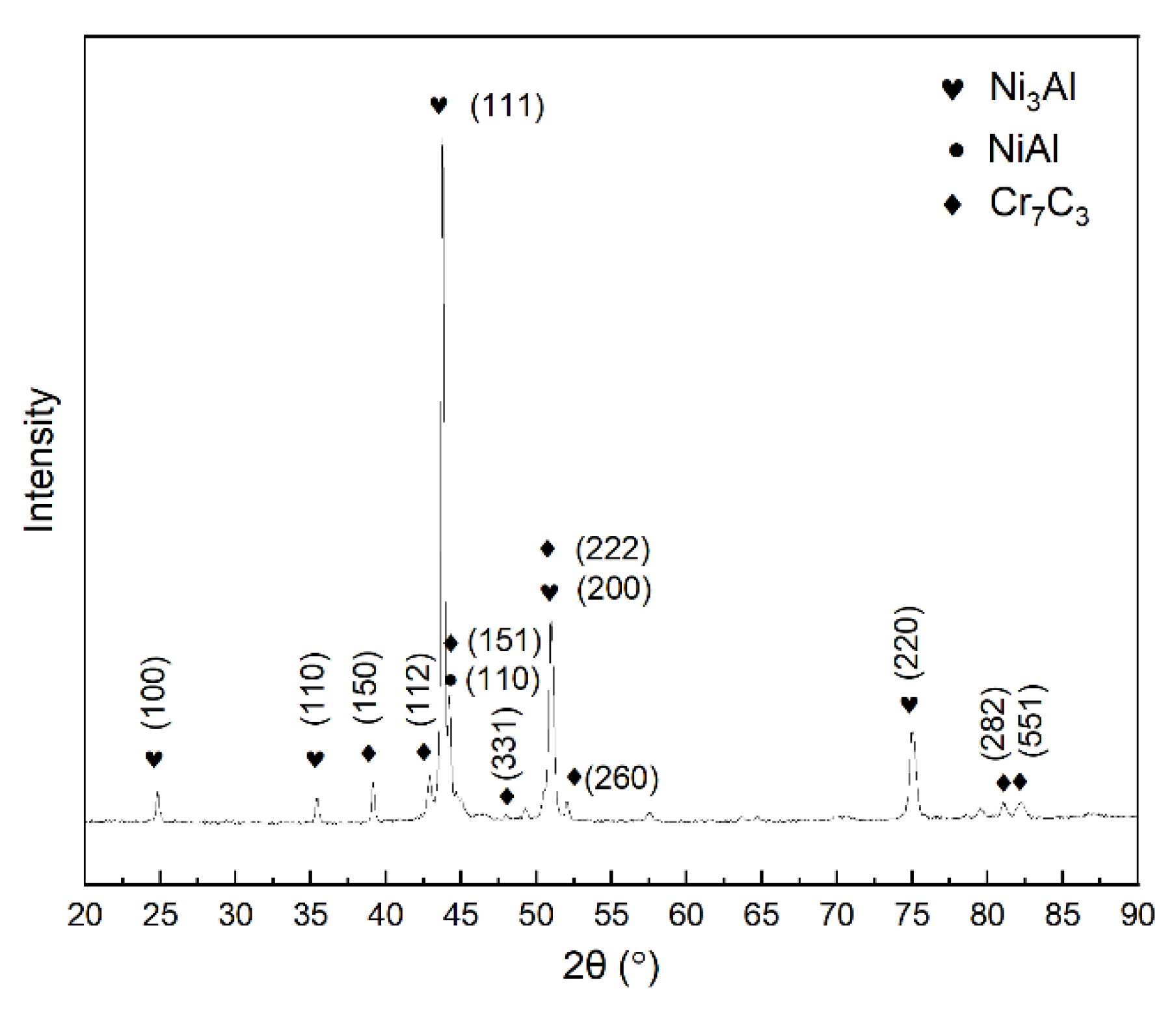




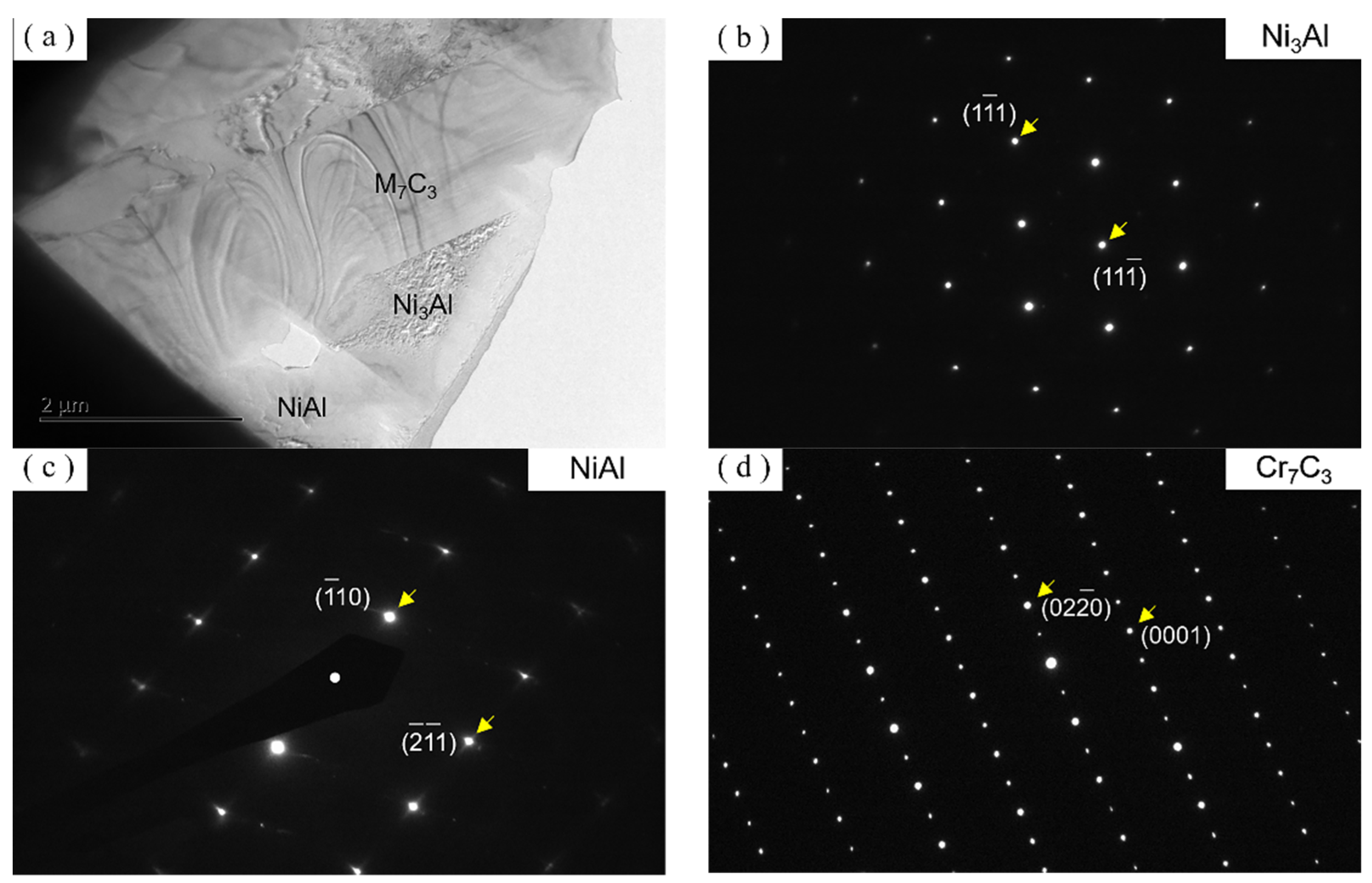
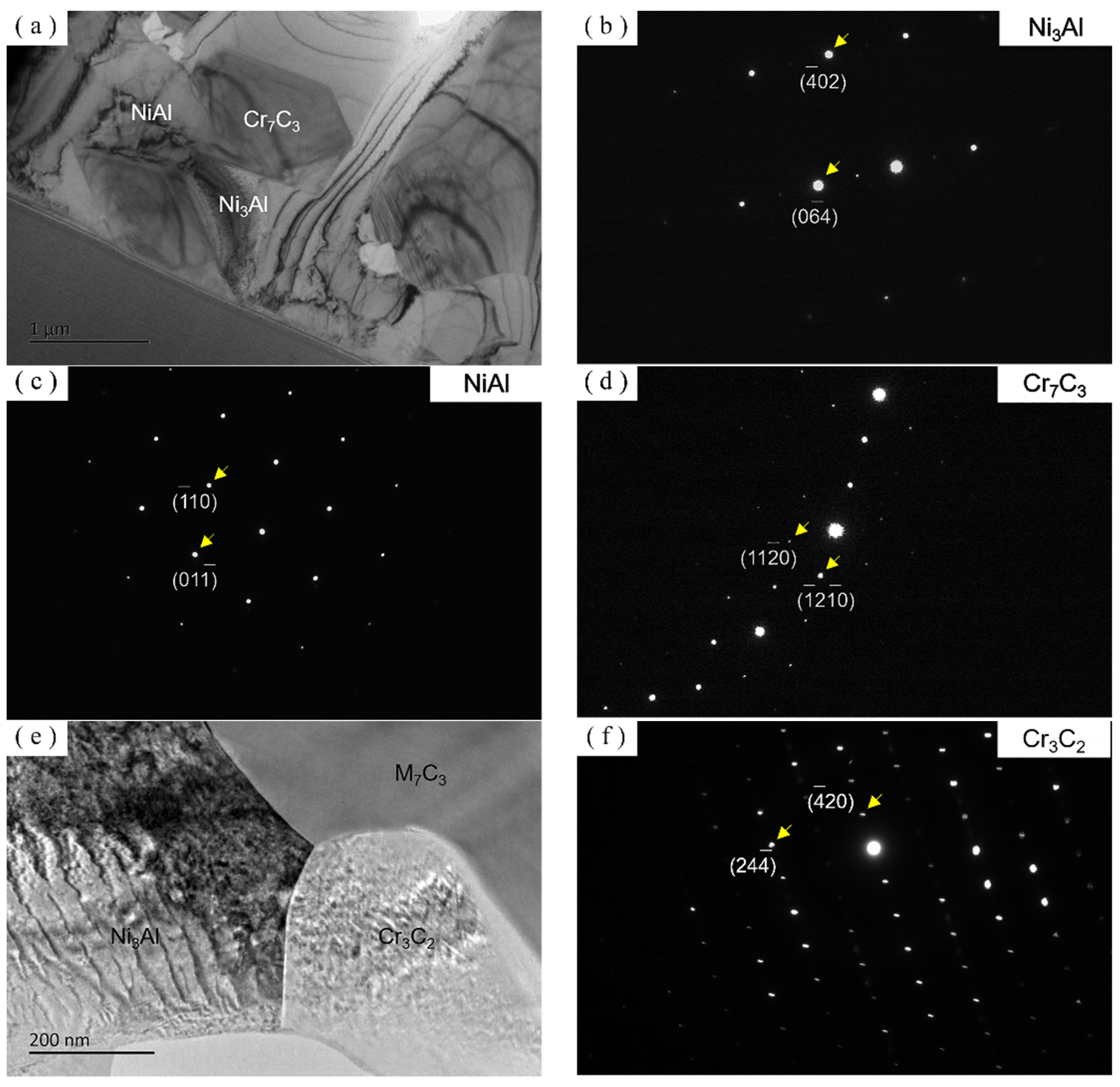
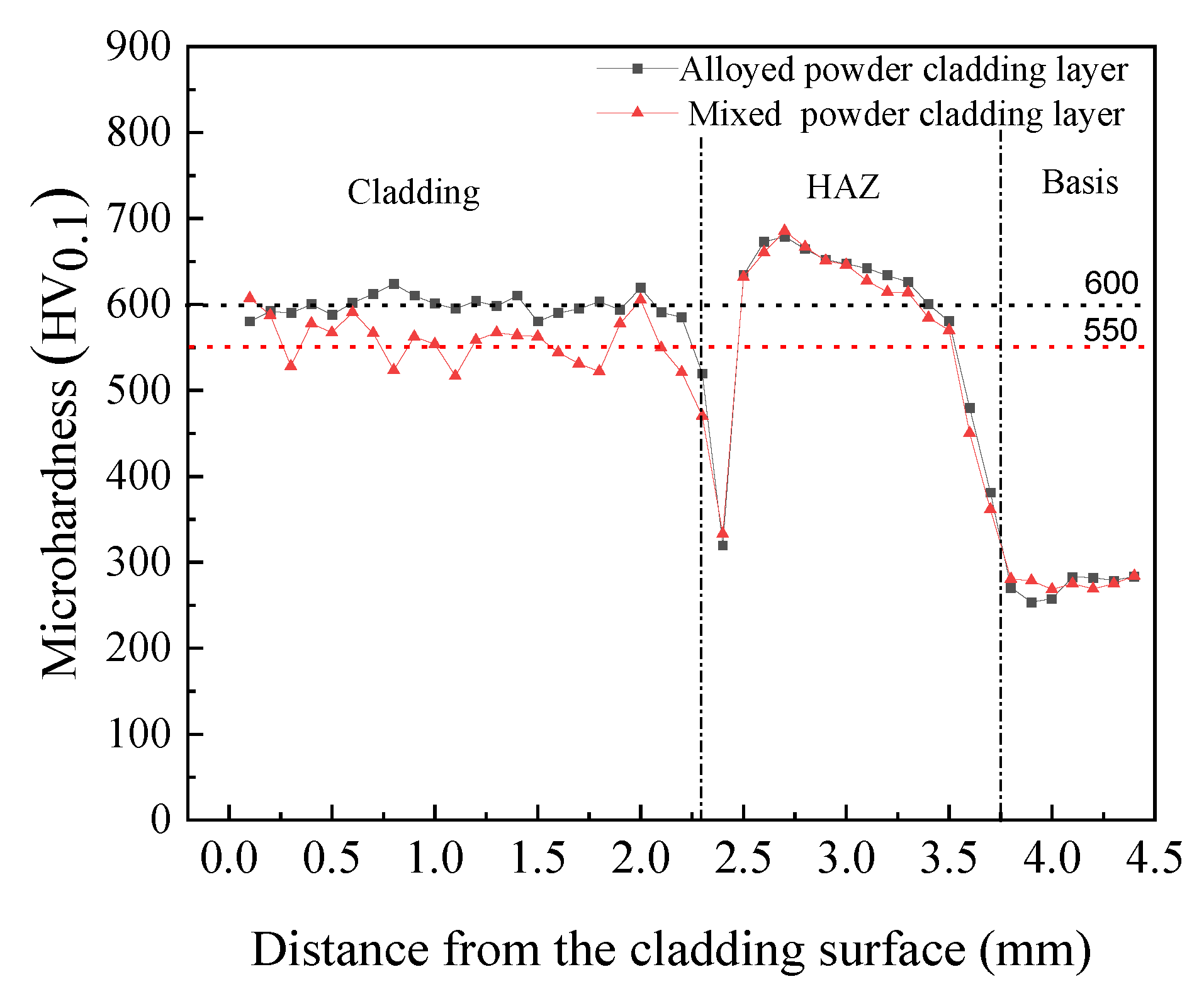

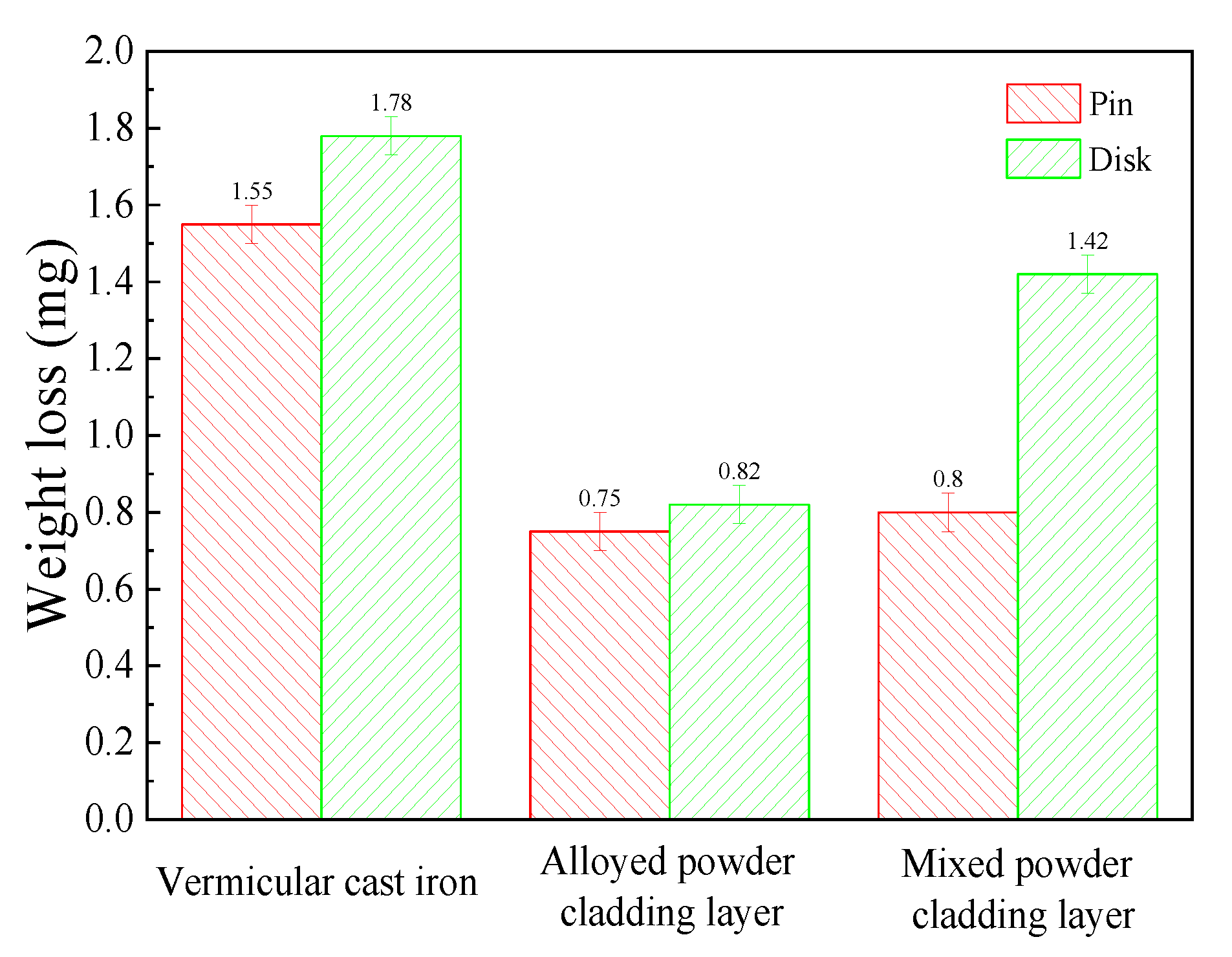
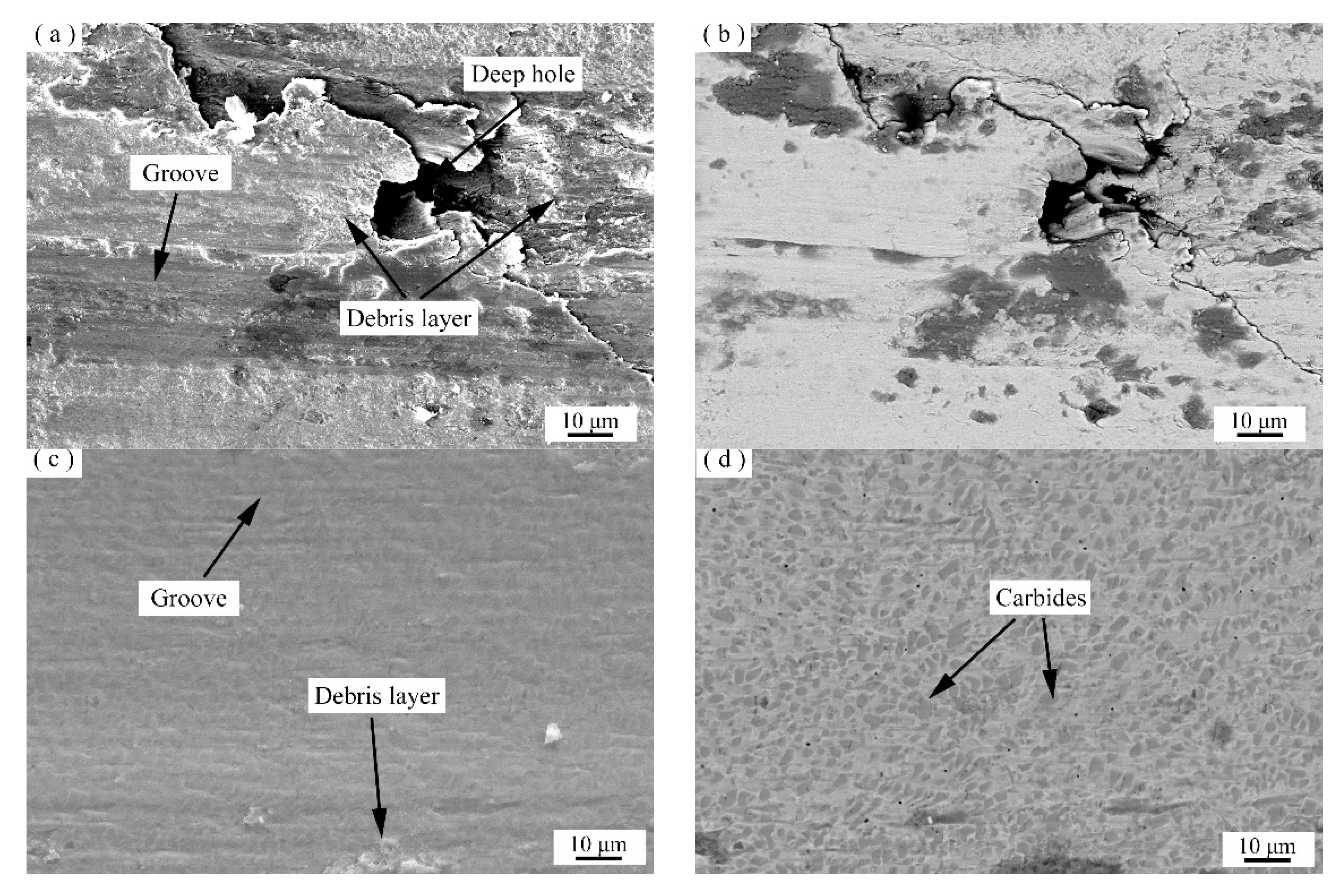
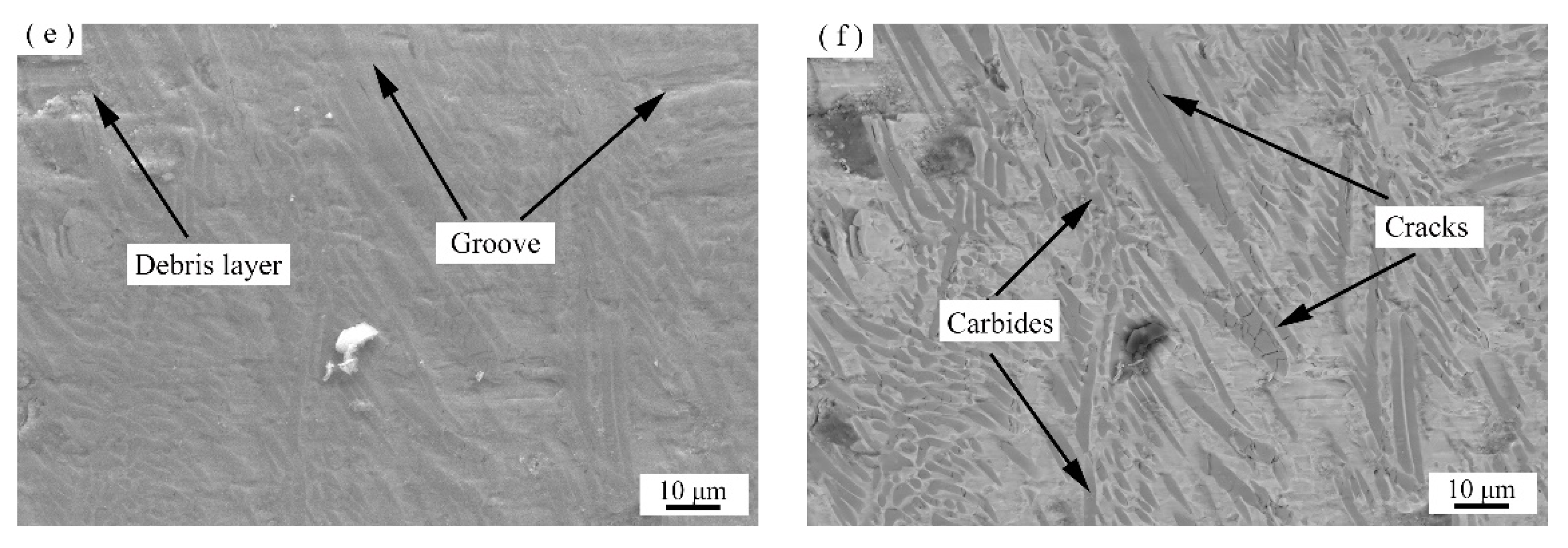
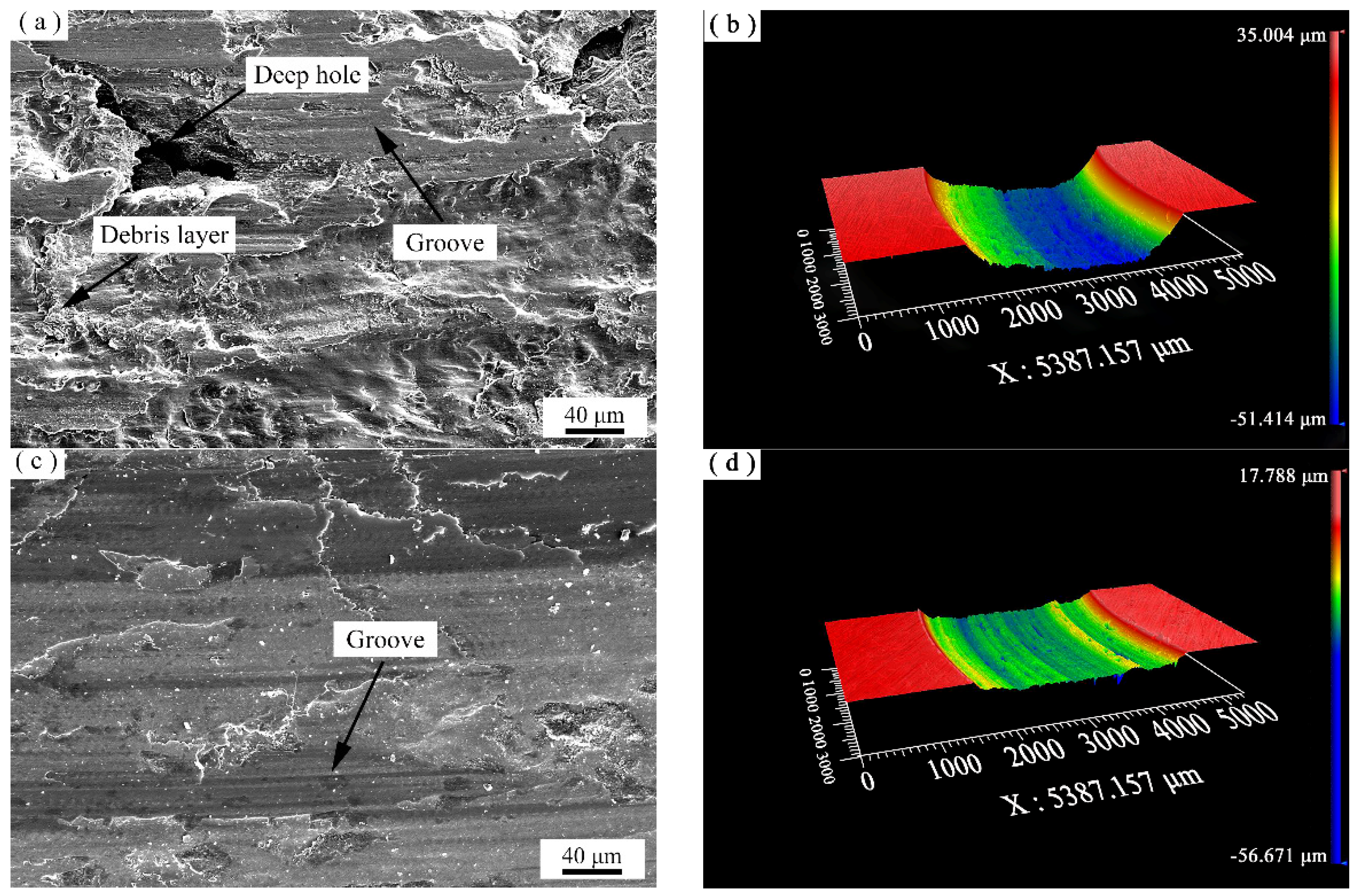
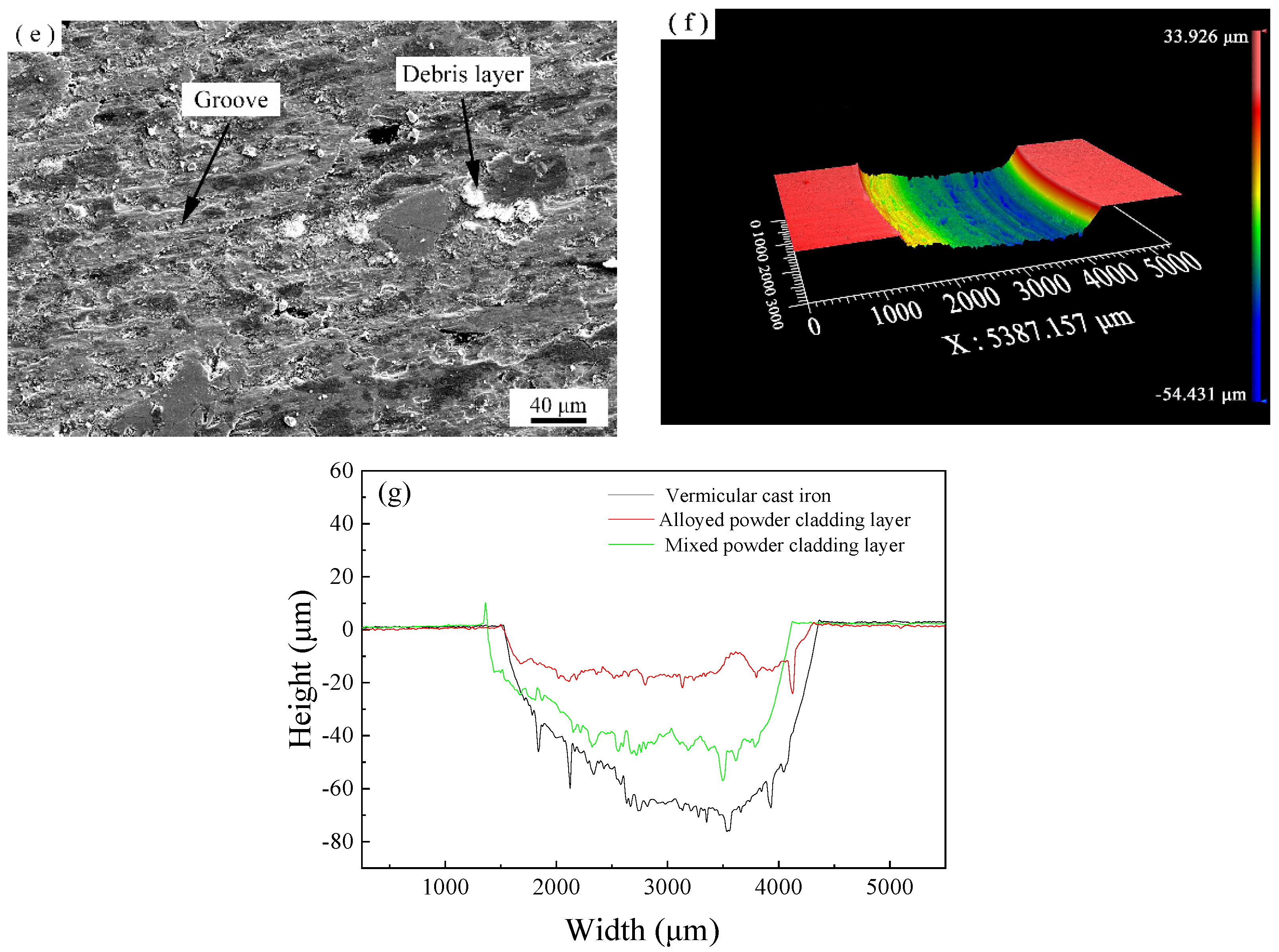
| Materials/Elements | C | Si | Mn | Cr | Mo | P | S | Fe | Ti | Ni | Al | B |
|---|---|---|---|---|---|---|---|---|---|---|---|---|
| 42CrMo | 0.43 | 0.25 | 0.56 | 1 | 0.22 | 0.003 | 0.014 | Bal. | / | / | / | / |
| Alloyed powders | 2.42 | / | / | 24.51 | / | / | / | / | / | Bal. | 9.62 | 0.02 |
| Ni3Al powders | / | / | 0.78 | / | / | / | / | 11.61 | 0.56 | Bal. | 9.52 | 0.02 |
Publisher’s Note: MDPI stays neutral with regard to jurisdictional claims in published maps and institutional affiliations. |
© 2022 by the authors. Licensee MDPI, Basel, Switzerland. This article is an open access article distributed under the terms and conditions of the Creative Commons Attribution (CC BY) license (https://creativecommons.org/licenses/by/4.0/).
Share and Cite
Liu, Z.; Yin, F.; Chen, C.; Zhao, L.; Fu, L.; Feng, Y.; Cao, Y.; Peng, Y.; Tian, Z.; Li, C. Microstructure and Wear Resistance of a Cr7C3 Reinforced Ni3Al Composite Coating Prepared by Laser Cladding. Coatings 2022, 12, 105. https://doi.org/10.3390/coatings12010105
Liu Z, Yin F, Chen C, Zhao L, Fu L, Feng Y, Cao Y, Peng Y, Tian Z, Li C. Microstructure and Wear Resistance of a Cr7C3 Reinforced Ni3Al Composite Coating Prepared by Laser Cladding. Coatings. 2022; 12(1):105. https://doi.org/10.3390/coatings12010105
Chicago/Turabian StyleLiu, Zhenbo, Fuxing Yin, Cuixin Chen, Lin Zhao, Lihua Fu, Yingkai Feng, Yang Cao, Yun Peng, Zhiling Tian, and Changhai Li. 2022. "Microstructure and Wear Resistance of a Cr7C3 Reinforced Ni3Al Composite Coating Prepared by Laser Cladding" Coatings 12, no. 1: 105. https://doi.org/10.3390/coatings12010105
APA StyleLiu, Z., Yin, F., Chen, C., Zhao, L., Fu, L., Feng, Y., Cao, Y., Peng, Y., Tian, Z., & Li, C. (2022). Microstructure and Wear Resistance of a Cr7C3 Reinforced Ni3Al Composite Coating Prepared by Laser Cladding. Coatings, 12(1), 105. https://doi.org/10.3390/coatings12010105





